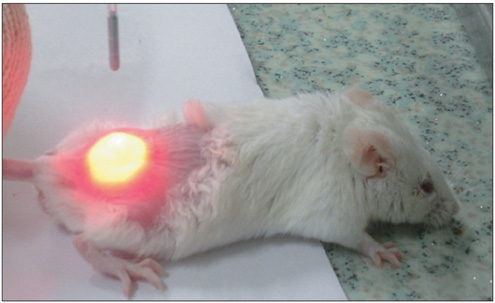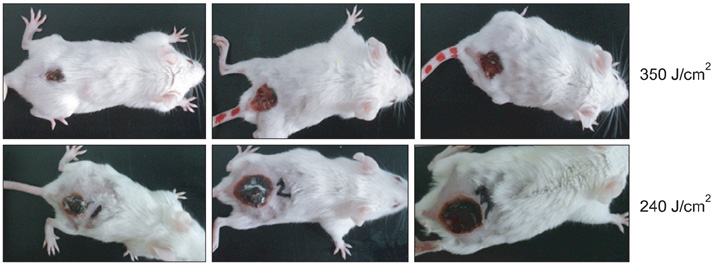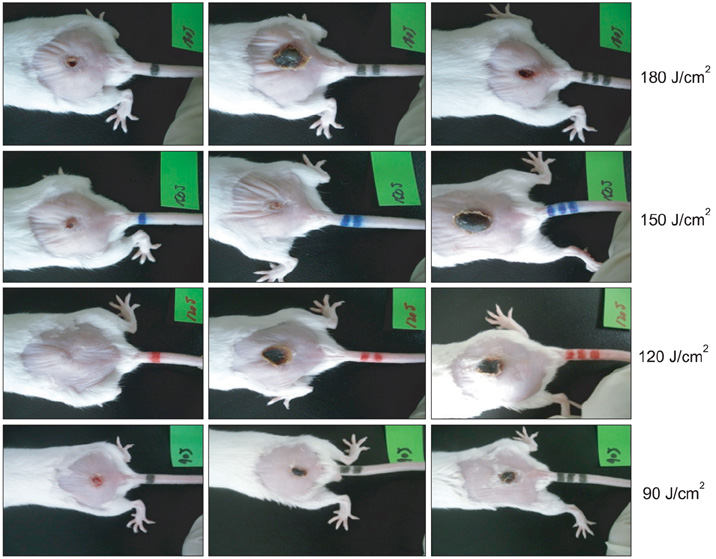J Gynecol Oncol.
2012 Apr;23(2):115-119. 10.3802/jgo.2012.23.2.115.
Photodynamic therapy for breast cancer in a BALB/c mouse model
- Affiliations
-
- 1Department of Obstetrics and Gynecology, Chosun University School of Medicine, Gwangju, Korea. sjhan@chosun.ac.kr
- 2Department of Biochemistry, Chosun University School of Medicine, Gwangju, Korea.
- 3Department of Obstetrics and Gynecology, Mirae and Heemang Women's Hospital, Gwangju, Korea.
- KMID: 2177585
- DOI: http://doi.org/10.3802/jgo.2012.23.2.115
Abstract
OBJECTIVE
Photodynamic therapy (PDT) has been used for superficial neoplasms and its usage has been recently extended to deeper lesions. The purpose of this study was to observe whether or not PDT can cure breast cancer in the solid tumor model, and to define the critical point of laser amount for killing the cancer cells.
METHODS
Twenty four BALB/c mouse models with subcutaneous EMT6 mammary carcinomas were prepared. Mice were divided into eight groups depending on the amount of illumination, and the tumor size was between 8 mm and 10 mm. We began by peritoneal infiltration with a photosensitizer 48 hours prior to applying the laser light, and then we applied a non-thermal laser light. The energy was from 350 J/cm2 to 30 J/cm2 to the cancer.
RESULTS
Regardless of the tumor size from 8 mm to 10 mm, all mice apparently showed positive results via PDT. We also did not find any recurrence over 90 J/cm2. In all models, the color of the breast cancer lesions began to vary to dark on 2 days post PDT and the tumor regression began simultaneously. Also, we confirmed the complete regression of the breast cancer 21 days after PDT.
CONCLUSION
We confirmed that PDT may treat breast cancers that are sized less 10 mm in mouse models. The moderate energy to destruct the breast cancer cells may be 90 J/cm2. Therefore, we can expcect that PDT may be utilized to treat breast cancer, but we need more experience, skills and processing for clinical trials.
Keyword
MeSH Terms
Figure
Reference
-
1. Epstein JH. Phototherapy and photochemotherapy. N Engl J Med. 1990. 322:1149–1151.2. von Tappeiner H, Jesionek A. Therapeutische versuche mit fluoreszierenden stoffen. Munch Med Wochenschr. 1903. (47):2042–2044.3. von Tappeiner H, Jodlbauer A. Uber die wirkung der photodynamischen (fluorescierenden) stoffe auf protozoen und enzyme. Dtsch Arch Klin Med. 1904. 80:427–487.4. von Tappeiner H, Jodlbauer A. Die sensibilisierende wirkung fluoreszierender substanzer: gesamte Untersuchungen ber die photodynamische erscheinung. 1907. Leipzig: FCW Vogel.5. Diamond I, Granelli SG, McDonagh AF, Nielsen S, Wilson CB, Jaenicke R. Photodynamic therapy of malignant tumours. Lancet. 1972. 2:1175–1177.6. Dougherty TJ, Kaufman JE, Goldfarb A, Weishaupt KR, Boyle D, Mittleman A. Photoradiation therapy for the treatment of malignant tumors. Cancer Res. 1978. 38:2628–2635.7. Dougherty TJ. An update on photodynamic therapy applications. J Clin Laser Med Surg. 2002. 20:3–7.8. Hopper C. Photodynamic therapy: a clinical reality in the treatment of cancer. Lancet Oncol. 2000. 1:212–219.9. Information for patients: lung cancer [Internet]. Oregon Medical Laser Center. c1999. cited 2011 Dec 10. Portland, OR: Oregon Medical Laser Center;Available from: http://omlc.ogi.edu/pdt/ptinfo/lungca/index.html.10. Photodynamic therapy for cancer [Internet]. National Cancer Institute. c2011. cited 2011 Dec 10. Bethesda, MD: National Cancer Institute;Available from: http://www.cancer.gov/cancertopics/factsheet/Therapy/photodynamic.11. Hamblin MR, Newman EL. On the mechanism of the tumour-localising effect in photodynamic therapy. J Photochem Photobiol B. 1994. 23:3–8.12. Juzeniene A, Peng Q, Moan J. Milestones in the development of photodynamic therapy and fluorescence diagnosis. Photochem Photobiol Sci. 2007. 6:1234–1245.13. Photofrin [Internet]. Pinnacle Biologics. c2011. cited 2011 Dec 10. Bannockburn, IL: Pinnacle Biologics;Available from: http://www.photofrin.com.14. Usuda J, Kato H, Okunaka T, Furukawa K, Tsutsui H, Yamada K, et al. Photodynamic therapy (PDT) for lung cancers. J Thorac Oncol. 2006. 1:489–493.15. Schuh M, Nseyo UO, Potter WR, Dao TL, Dougherty TJ. Photodynamic therapy for palliation of locally recurrent breast carcinoma. J Clin Oncol. 1987. 5:1766–1770.16. Sperduto PW, DeLaney TF, Thomas G, Smith P, Dachowski LJ, Russo A, et al. Photodynamic therapy for chest wall recurrence in breast cancer. Int J Radiat Oncol Biol Phys. 1991. 21:441–446.17. Wyss P, Schwarz V, Dobler-Girdziunaite D, Hornung R, Walt H, Degen A, et al. Photodynamic therapy of locoregional breast cancer recurrences using a chlorin-type photosensitizer. Int J Cancer. 2001. 93:720–724.18. Hogset A, Prasmickaite L, Selbo PK, Hellum M, Engesaeter BO, Bonsted A, et al. Photochemical internalisation in drug and gene delivery. Adv Drug Deliv Rev. 2004. 56:95–115.
- Full Text Links
- Actions
-
Cited
- CITED
-
- Close
- Share
- Similar articles
-
- Effects of cisplatin on photosensitizer-mediated photodynamic therapy in breast tumor-bearing nude mice
- The Effect of Photodynamic Therapy in BALB/-c Mice Adenocarcinoma in Homograft Model
- Mouse models of breast cancer in preclinical research
- Canine as a Comparative and Translational Model for Human Mammary Tumor
- Photodynamic Therapy for Esophageal Cancer






